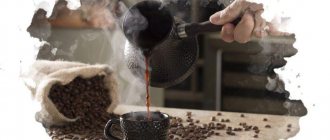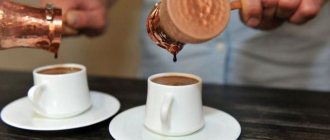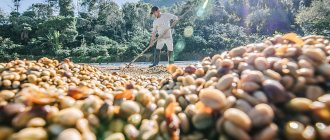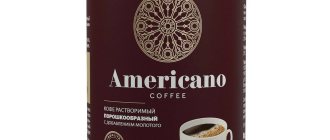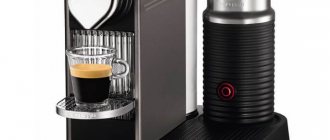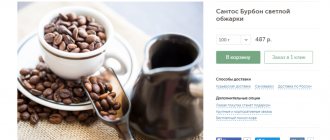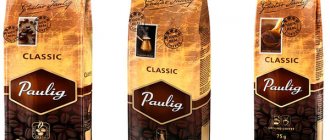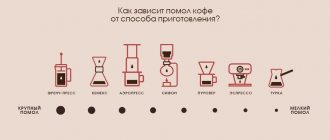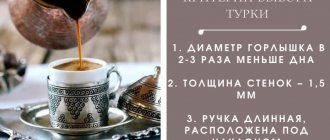Lately, we have begun to frequently receive questions of the same type from our regular readers. These queries can be formulated in one phrase: cezve and turk – are there differences between them or not? We were slightly confused by this formulation, and after some research it became clear that this question is often asked not only to us, but to many fans of good coffee. Today we decided to finally put an end to this issue by talking about the Turk, and the cezve, and other related devices for manually preparing the drink.
Utensils used for brewing coffee before the advent of the cezve
Such jugs became the ancestors of modern utensils for brewing coffee called dalla.
The very first and primitive vessel for brewing robusta or arabica coffee was a copper or bronze pot with a lid. But such a pot was too bulky and inconvenient for African peoples wandering from place to place. So the vessel gradually began to decrease in size and began to evolve in several directions at once.
Nomadic tribes who joined the nomads in the desert began to brew coffee in water jugs that had a narrow elongated neck
Other peoples who moved to the Arabian Peninsula joined the merchants from the East. Traders, captivated by the aroma and taste of coffee, made it popular in the Sultan's palace. Coffee for the Sultan was brewed in small saucepans with a lid, made of gold and with long handles for easy grip. Such saucepans contained a portion for one person and were served immediately after cooking.
How to make coffee in a Turk/Cezve
Cezve / Turk
Cezve (Turkish Cezve) is a device for making coffee, cone-shaped with a narrow neck and a long handle, traditionally made of copper. Cezve is the oldest method of preparing coffee and remains the most popular home method. Coffee prepared using this method is very rich and dense.
Story
Back in the 9th century, African nomads brewed coffee over coals in copper pots, as this was the most common material at that time. Due to constant movements, it was quite problematic for nomads to take large-volume dishes with them, so gradually the coffee pot noticeably decreased in size and narrowed, and thus a new dish - dalla - appeared.
Dalla is a metal jug with a spout and a long handle. As nomads moved, in the 15th century, dallah, along with coffee, ended up in the Arabian Peninsula, where it was appreciated by Turkish merchants. The Turks noticeably changed the structure of the dalla: they narrowed the neck so that the coffee did not spill and made the handle longer for convenience, so a new vessel called a cezve appeared.
Already in the 17th century, the cezve appeared in the Russian Empire and received its name “Turk” due to the fact that it was brought from Turkey. So there are no differences between cezve and Turkish .
Over the past few years, Turka has begun to develop in the specialty coffee industry. In 2014, the first coffee shops opened in Russia, serving specialty Turkish coffee. Their founder is three-time Russian cezve champion Maria Hyuppenen.
Cezve championships are held under the auspices of the SCA, where coffee taste, technique, and roasting are assessed. The participant needs to prepare a signature drink and traditional coffee in a cezve in pairs. The main goal of the championship is to reveal the potential of the Turka as a tool for working with good coffee. If earlier oriental coffee was considered a traditionally sweet drink with a bunch of different additives, then gradually this attitude is changing and now we can use the cezve as a tool to reveal the taste of coffee.
Design and principle of operation
The cezve is traditionally made of tinned copper, but there are many options on the market made of stainless steel, crystal, ceramics, aluminum, and clay. They all have advantages and disadvantages.
Aluminum pot is the most affordable and unpretentious, but often these options are irregular in shape, which makes the drink not so tasty, the same with steel models. Cezves made of ceramics or crystal differ in their appearance, the materials are completely safe for humans, the only drawback is their fragility.
The selected material significantly affects the taste of the future drink. Thus, a copper cezve has high thermal conductivity, which contributes to more uniform heating. Inside, it is usually coated with food-grade tin or silver, since these materials are harmless to humans, do not emit harmful substances and do not come into contact with the contents, such as copper.
The Turka has a trapezoidal shape: it has a narrow neck and a wide bottom. The narrow neck of the Turk promotes the formation of a thicker layer of “coffee head” (cream), which minimizes contact between the drink and the open surface and prevents the evaporation of coffee aroma and essential oils. The neck should be 20% narrower than the bottom. This trapezoidal shape is not accidental; it is made so that the coffee grounds do not “run away” during the preparation process, but rise along the walls of the pot and wrap from the edges to the center, thereby ensuring mixing, and then sink to the bottom and concentrate there. As a result, the drink is cleaner, without a suspension of small coffee particles or with a minimal content of them. If you take a Turk with a wide neck, the cream will be thin due to the larger diameter of the open surface, the mixing of coffee particles will be poor, and the edges of the cap will burn.
The size of the Turk will determine the volume of the drink, since the water must be poured close to the neck, again to form a thick layer of cap and minimal open surface area.
Turku can be cooked on almost any heating element. This could be a gas or electric stove, coals, oven, sand. The only problem may be cooking Turka on an induction stove, since the stove “does not see” it. Just place a frying pan under the Turk.
Brew coffee in a cezve
Coffee prepared this way is high in caffeine due to the extraction process.
- Coffee . We recommend choosing coffee roasted using filter methods. Because coffee roasted with espresso is easy to over-extract.
- Grinding _ It is traditional to use ground coffee, but we recommend using a grind closer to espresso, as grinding too fine will negatively affect the taste of the coffee.
- Water . The most important component of any coffee drink. We recommend using non-cold water (room temperature). The initial temperature of the water affects the brewing time of the coffee and the duration of the extraction.
- Capacity _ Choose the volume of the cezve based on the volume you want to get in your cup. It is better to use a cezve for making coffee in portions. Coffee brewed in a cezve due to the lack of filtration, and therefore the content of coffee particles in the drink, continues to be extracted in the cup, so you should not divide the drink into several servings.
The total time varies depending on the volume of the vessel, and can range from one to two minutes and up to five minutes.
We often come across the opinion that it is better to prepare coffee in a Turk by periodically removing its heating when the cap is raised and returning it, but if we return the Turk again for heating, we are preparing a ready-made coffee drink, since when the coffee cap is raised, the temperature of the drink is 88- 96 degrees.
The standard proportions for coffee in a cezve are 1:10 coffee and water, that is, if your cezve is 200 ml, then you will need 20 grams of coffee. Depending on your taste preferences, you may need more or less coffee.
You should choose coffee depending on your taste preferences. We decided to cook in Turkish Rwanda Gisheke. For this:
- We will need 15 grams of coffee per 150 ml of water (the proportions depend on the volume of your Turk),
- Distribute the ground coffee over the bottom of the Turk and fill it with water at room temperature. Stir coffee with water to prevent lumps from forming.
- Place the Turk on low heat/heat.
- After some time, coffee foam will form and begin to rise. It is IMPORTANT to carefully monitor the process and remove the Turk from heating until it boils; as soon as the coffee foam rises to the edges of the Turk, remove it from the heat. The total cooking time will be about 2.5 minutes.
- Carefully pour the drink into the cup, try not to damage the resulting cream and pour only the drink into the cup.
- We advise you to wait 1 – 2 minutes before starting to taste the coffee. During this time, all the coffee particles will settle to the bottom, and the coffee will become a comfortable temperature.
Perfect!
History of the origin of the cezve
The problem with the golden saucepans was that the drink boiled very quickly and overflowed over them. This fact provoked the appearance of saucepans made of tinned copper with a thick, wide bottom and a narrow neck. The advantages of such cookware were slow heating due to the copper bottom and prevention of runoff due to the narrow neck. They decided to leave the long handle in the new design, similar to an oriental woman.
The narrow neck of the Turk saves coffee from running away
An interesting fact is that such a container was named “rakva”, in honor of the rich nobleman who began its continuous production and sale. Over time, the name “rakva” was forgotten, and the container for brewing the drink began to be called “dzhezva”.
Why did the cezve come to be called the Turk?
In Russia, coffee is traditionally brewed in a Turkish pot, and few people wonder why this is the name of a vessel that is so similar to a Turkish cezve. There are two points of view on the origin of this term.
Most archaeological scientists believe that there is no difference between a Turka and a cezve, and that the term “Turka” simply entered into use among the Russian people as a word that is easier to use than the foreign “cezva.”
Since coffee appeared in Turkey much earlier than in Russia, Turkish merchants had to take the cezve with them on voyages to enjoy their favorite drink away from home. Over time, coffee began to gain popularity in our country, and the utensils for preparing it began to be popularly called “Turks” - after the nationality of the people who so actively use it. But in essence, these two devices are no different from each other.
Experts say that cezves are made from copper, and Turks are made from any other materials
Adherents of the second point of view argue that the Turk is a type of cezve and has a wider and shorter neck. Also, cezves are traditionally made from heavy forged copper, but Turks can now be found - in addition to copper - from steel, aluminum, brass and even ceramics.
What other container can you use to brew coffee?
It should be said that coffee is brewed not only in cezves and Turks. In other countries, such vessels are called differently and have some distinctive features.
Ibrik
Currently, coffee is practically not brewed in Ibrik.
A water jug, in which it was convenient to brew coffee over a fire. As a rule, it is made of copper and is closed with a lid. A distinctive feature from the cezve is the long spout and curved handle. Currently, ibrik is used for its intended purpose - for storing water.
Dalla
From the outside, the dallah resembles a teapot.
Utensils for making coffee, now widely used in Syria and Saudi Arabia. Unlike ibrik, dalla has round sides shifted to the lower part of the vessel and an elongated spout, which is slightly wider. Dallu is made from different materials from brass to gold. It is best to brew finely ground coffee in a dalla. Boil such dishes on a fire or a regular stove, not induction.
Jebena
This vessel looks like a wine bottle with a spout.
Another relative of the ibrik. The main difference from its ancestor is the shortened spout, into the base of which a horsehair filter is inserted to retain coffee grounds.
Percolator
Percolators are either electric or for the stove.
A special coffee pot that has an important feature in brewing technology. In order to prepare the drink, you need to pass hot water through a special container with ground coffee. A percolator is similar to a regular kettle. Made of steel, it would have served the family for many years if it had not been replaced by modern units. You can make any coffee in it - Japanese bushido, carte noire, mokkona, ambassador.
No matter how far progress has gone, coffee lovers will still prefer manual brewing in time-tested devices decades from now. Turka is a kitchen resident of almost every Russian family, where real aromatic coffee is served every morning. Moreover, pregnant women, people with diabetes, and those who want to lose weight drink it.
Cooking process
If you add spices, they must be added to the water along with the coffee. Pour the ground coffee into a cezve with water, mix the coffee thoroughly, and put it on the fire (or in hot sand). There is no need to stir the coffee further.
When the coffee cap rises, remove the cezve from the stove (or sand). No three lifts! Your coffee is almost brewed and will continue to extract in the cup. There is no need to overheat it, otherwise we will get an overextracted and bitter drink. Do not splash cold water on your coffee.
You can pour coffee into cups along with the coffee suspension. Immediately after preparation, the drink in the cup has a silty, thick texture. If the grain was lightly roasted, and we did not overheat it or boil it, then the silty suspension will taste pleasant (although not for everyone, of course). If you wait a little, the coffee particles will settle and you can drink a clean, rich drink.
Write your secrets of delicious Turkish coffee in the comments!
